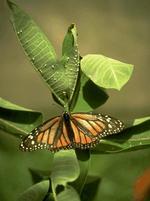


Today's News


Monarch Butterfly Migration Update: May 6, 1997
- Link to Latest Migration Map
- Link to Today's Migration Data
The monarch migration pushes on! Another 25 new sightings were reported this week, including the first from Nebraska. Also for the first time, many observers are beginning to notice monarchs with fresh wings. This means butterflies of the new spring generation are now on the wing; presumably these fresh butterflies are not migrants from Mexico. Here's an example from Virginia:
April 29
"Ricky, Andrew, Victor, Brett, Dristen, Pankaj, and Raphael saw a monarch on our school playground at 1:10 p.m. The temperature was in the low 70's, and it was sunny and a little breezy. The wings were fresh, and the butterfly was flying around over the grass near
some trees."
pskibins@aol.com
McLean, VA
In contrast, read this report from Kansas:
April 26
"The first two monarchs we saw were pretty tattered, the third one was very tattered, but it laid eggs on our milkweed plant in our butterfly garden. The milkweed is just coming up, was only about three inches high when the eggs were laid. It has now grown to about six inches, but isn't enough to feed all those caterpillars! There are quite a few flowers blooming now, but we didn't observe the monarchs nectaring."
Valley Center, KS
betty@mother-earth.com
Karen Oberhauser
 Concerns About Early Migration
Concerns About Early MigrationAs mentioned in a previous report, Dr. Lincoln Brower believes this spring's migration began unusually early and is progressing too rapidly. He is concerned that monarchs left Mexico early because the microclimate in their winter sanctuaries has been changed as a result of logging of the pine forests. Supporting his concern are this spring's reports about monarchs laying masses of eggs on the newly emerged milkweed.
"My observations of monarchs returning from Mexico to north central Florida in late March and early April have year after year indicated that females almost never lay more than one or two eggs per oviposition event. I suspect that observations indicate egg dumping by monarchs coming up so early from Mexico that have been unable to find milkweeds."
Dr. Brower wants to document how far north the monarchs from Mexico have traveled this spring, as a way to support his concern about early migration. Right now, he is collecting samples of monarchs from across the U.S. and Canada. Because this spring's migration is unique, and because the monarchs are reproducing quickly, he has only a few weeks to spare.
His research question: Which butterflies are directly from Mexico and which are offspring of the new spring generation (i.e. those produced in the southern states this spring)?
Wing condition is one clue: Monarchs with fresh wings obviously cannot be migrants from Mexico. What about monarchs with faded wings? How can he be sure they are from Mexico? Dr. Brower will take "individual cardenolide fingerprints" of the butterflies he collects. Fingerprints from butterflies?!
- Click Here to Read More about Dr. Brower's Research.
Here they are!
 Early Monarch in Massachusetts
Early Monarch in Massachusetts
As promised, Katie Gengarelly (gengarel@capecod.net) sent these wings from one of the 2 monarchs she sighted on Cape Cod, Massachusetts in early April. These certainly are monarch wings! (Do you know how to tell the difference between monarch and viceroy butterflies?) As you may recall, this is a very early sighting for Massachusetts. (See chart below.) Look at the migration map and other sightings from early April. Her sighting raises some fascinating questions:
- Do you think this monarch flew all the way from Mexico to Cape Cod?
- What other explanations could there possibly be?
- What were the wind & weather conditions in the Northeast in early April that might have carried this butterfly to Cape Cod?
| Year | Date |
| 1994 | 5/17/94 |
| 1995 | 5/24/95 |
| 1996 | 6/06/97 |
| 1997 | 4/07/97 |
Special thanks to Katie for her careful field observations!
Analyzing Migration Patterns, Year to Year
How does this spring's monarch migration compare those in previous years? Summaries of April migration data collected by Journey North during 1995, 1996 and 1997 are provided below. What does this information tell you---and what doesn't it tell you---about monarch migration?
April Migration Data
- Link to 1997 April Data Summary
- Link to 1995 & 1996 April Data Summary
- Link to 1996 April Migration Map
March Migration Data
Consider This:
- Do you think these data suggest this spring's migration is earlier than those in previous years?
- If so, how can you quantify this?
- List all the factors you think might cause the migrations to be different in 1995, 1996 & 1997.
- List all the factors that might cause the data to be different from year to year.
- Review the lesson, "You're the Scientist: Verifying Data Collected by Peers".
(Also see page 55 of the Journey North Teacher's Manual.)




